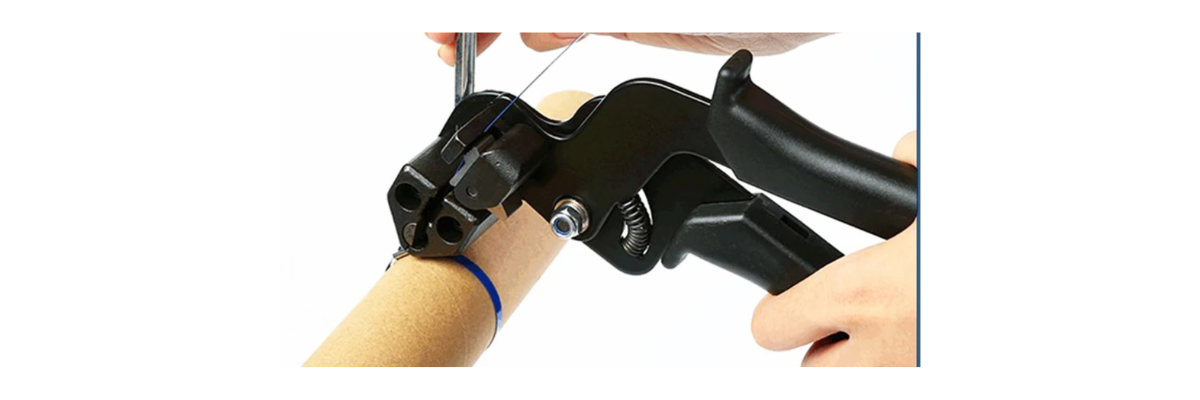1-877-445-6744 Live Support
1-877-445-6744 Live Support

Metal zip ties are a highly durable and versatile solution used across industries like construction, automotive, electrical work, and aerospace. They provide unmatched strength and resistance to extreme conditions, including high temperatures, UV exposure, and corrosion. However, one of the common challenges people face when working with metal zip ties is learning how to cut them efficiently and safely.
Unlike their nylon counterparts, metal zip ties require specialized tools and techniques for proper handling. Whether you're a professional using them in an industrial setting or a DIY enthusiast tackling a home project, knowing the best ways to cut metal zip ties can save you time, effort, and potential injury.
Metal zip ties, often referred to as stainless steel cable ties, are fasteners made primarily from stainless steel. They are designed to secure heavy loads, withstand harsh environments, and provide a long-lasting solution for bundling and fastening. Common uses include:
• Industrial Applications: Securing pipes, ducts, or heavy cables in construction and manufacturing.
• Automotive: Bundling wires and hoses in engines where high temperatures exist.
• Marine: Withstanding saltwater and corrosive conditions on boats or docks.
• Aerospace: Used for securing critical components in extreme environments.
Metal zip ties are preferred in applications where nylon or plastic ties would fail due to heat, weight, or chemical exposure. However, cutting them can be tricky because of their strength and material composition.
Metal zip ties are inherently stronger and more rigid than nylon ties. This durability, while beneficial for securing items, makes them harder to remove or cut. Several challenges arise:
1. Sharp Edges: After cutting, the leftover edges of metal zip ties can be sharp and potentially hazardous, posing a risk of injury.
2. Material Resistance: Stainless steel is tough and resists standard cutting tools, requiring specialized equipment.
3. Precision Needs: Cutting too close to the locking mechanism or leaving rough edges can affect functionality and safety.
For these reasons, it’s crucial to use the right tools and techniques to ensure safety and efficiency.
Here are the best tools for cutting metal zip ties:
1. Wire Cutters
High-quality wire cutters with hardened steel blades are suitable for cutting thinner metal zip ties. Look for heavy-duty versions designed for cutting through tough materials.
2. Bolt Cutters
For thick or heavy-duty metal zip ties, bolt cutters are the ideal tool. They provide the necessary force to cut through the stainless steel quickly.
3. Snips or Aviation Shears
Aviation shears or heavy-duty snips are designed to cut through metal sheets and are effective for trimming metal zip ties.
4. Angle Grinder
For industrial applications where precision isn’t the top priority, an angle grinder can quickly cut through multiple metal zip ties. However, it should be used cautiously.
5. Metal-Specific Scissors
Some specialized scissors are designed to handle metal. These can be useful for cutting thin stainless steel zip ties.
6. Dremel Tool
A Dremel with a cutting attachment can be used for precise cuts, especially in tight spaces.
Follow these steps for a safe and efficient process:
Step 1: Assess the Zip Tie
• Determine the thickness and tension of the zip tie. This will help you select the right tool for the job.
• Check for sharp edges or fraying.
Step 2: Choose the Right Tool
• For light-duty ties, use wire cutters or snips.
• For heavy-duty ties, opt for bolt cutters or an angle grinder.
Step 3: Position the Tool
• Hold the zip tie firmly to prevent movement.
• Align the cutting blades of your chosen tool near the locking mechanism, leaving a small gap for a clean finish.
Step 4: Make the Cut
• Apply steady pressure to cut through the tie. If using a Dremel or angle grinder, move slowly to avoid overheating or damaging nearby surfaces.
Step 5: Smooth the Edges
• Use a metal file or sandpaper to smooth any sharp edges left behind after cutting. This step is crucial for safety.
When working with metal zip ties, safety should always be a top priority. Here are essential precautions to take:
• Wear Protective Gear: Always wear gloves and safety goggles to protect against sharp edges and flying debris.
• Use the Right Tool: Avoid using inappropriate tools, as they may slip or fail to cut through the material effectively.
• Secure the Zip Tie: Hold the zip tie firmly or clamp it in place to prevent movement during cutting.
• Inspect the Tool: Ensure your cutting tool is sharp and in good condition to avoid uneven cuts.
• Dispose of Fragments Safely: Collect and dispose of sharp metal fragments to prevent injury.
• Cut Close to the Locking Mechanism: Leave just enough material to prevent the tie from loosening.
• Use Proper Lighting: Work in a well-lit area to ensure precision.
• File Down Sharp Edges: Smooth the cut edge to prevent injury or damage to surrounding materials.
• Using the Wrong Tool: Attempting to cut metal zip ties with standard scissors or dull tools can lead to frustration and uneven cuts.
• Rushing the Process: Cutting too quickly can result in jagged edges or damage to the surrounding area.
• Neglecting Safety Gear: Failing to wear gloves or goggles increases the risk of injury.
Metal zip ties are indispensable in heavy-duty applications, but cutting them requires the right tools and techniques to ensure safety and efficiency. By understanding the types of tools available, following a step-by-step process, and prioritizing safety, you can cut metal zip ties cleanly and effectively.
Investing in high-quality tools and practicing proper techniques not only makes the process easier but also ensures the longevity and reliability of the items secured by your zip ties. With this comprehensive guide, you're now equipped to handle even the toughest metal zip ties with confidence!